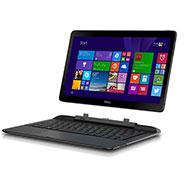Review: Dell Latitude 13 2-in-1 A So-So Tablet, Laptop

Dell makes some pretty good laptops that run the gamut from thin and light to fast and furious. It also has made some stinkers. Somewhere in the middle is the Latitude 13 7000 Series 2-in-1, a convertible system introduced in September and updated with Broadwell last month. Its mediocrity comes as no surprise, really. Because when a laptop tries to be a tablet, it's at odds with itself and can do neither thing well.
The Latitude 13 2-in-1 is a great-looking device. Its 13.3-inch IPS panel puts out a bright 1,920-x-1,080 pixels, and its 10-point capacitive touch screen is as accurate as it is responsive. The tablet's edge-to-edge glass and full HD display are truly beautiful. On the downside, one drop and it's all over -- a frailty that's likely to be a deal-killer for many outdoor applications. And except for the headset jack, the tablet itself has no ports; loading files or apps has to be done wirelessly or through the backlit keyboard dock. Intel dual-band Wi-Fi ac and Bluetooth 4.0 LE are standard. A SIM slot and Dell's LTE card are optional.
On the rear face of the keyboard-dock are located two USB 3.0 ports, a mini-DisplayPort output and the power input. The SD card slot is placed on the right edge near the front. A power and battery-charge indicator LED is on the mounting ridge above the keyboard's upper-left corner and is visible with the unit open or closed. The keyboard itself is a full-sized chiclet-style affair with a wide, comfortable wrist-rest. A large touchpad with integrated buttons supports multifinger gestures.
The Series 7000 is available only with Windows 8. Dell will preinstall 64-bit versions of Windows 8.1 or 8.1 Pro, the primary difference being Pro's ability to join a domain, accept group policies, operate as a Hyper-V client and side-load business apps. The more secure and manageable Pro edition also includes BitLocker and can host Remote Desktop sessions.
The tested unit was equipped with an Intel Core M-5Y71 dual-core, four-thread processor running at 1.2GHz. A 4.5-watt thermal design power (TDP) is at the high end of the Core-M spectrum. Dell also offers a vPro option. Also on board was 8 GB of RAM and a 256-GB SSD, both of which double the unit's default and are half of its maximum. The tablet has a three-cell Li-Polymer battery; the dock has a two-cell battery of the same kind. Before testing, we charged the Latitude 13 overnight. The system includes a small 45-watt power supply with a 3-foot AC cord and 6-foot DC cord with lighted tip.
With batteries charged and AC power connected, we installed and launched Geekbench 2.4 to get some performance benchmarks. With Windows properties set for maximum performance, the system under test turned in a high geekscore of 8,183, which narrowly missed getting on CRN's Top 10 Fastest Laptops. However, the Broadwell-based convertible did score points for long battery life. Our standard battery test cranks the screen brightness to maximum, leaves all other power-saving measures alone and runs a digital video file continuously until the battery runs out. In a test with both batteries, the Latitude 13 delivered 8 hours and 22 min. The tablet's three-cell battery recharged in about 3 hours and then delivered 5 hours and 44 minutes of continuous use.
As a laptop, the Latitude 13 is thicker than most Ultrabooks and not nearly as feathery. And as a tablet, Dell's convertible is big and heavy. The slab measures a zaftig 12.5 inches by 8 inches and weighs a wrist-wresting 3.7 pounds. By comparison, Samsung's 12.2-inch Galaxy Note 12 Pro weighs a comparatively gaseous 1.7 pounds, which we also deemed too heavy for all-day use. For controls, the unit has the usual power button, volume rocker and Windows button, which toggles between the Start screen, and either the Desktop or a dominant app (such as a video player). Pressing the power or Windows button will wake the unit from sleep. List pricing starts at $1,199; the Latitude 13 as tested would list for $1,640.
PUBLISHED FEB. 25, 2015